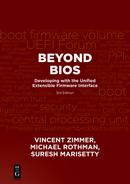Chapter 1 provides a description of the evolution.
The rest of the book is organized into two major sections. The earlier chapters present an introduction to UEFI, and the later chapters cover the Platform Initialization.
Chapter 2 provides an overview of the basic UEFI architecture. This is a must-read for anyone seeking an understanding of the Unified Extensible Firmware Interface (UEFI).
Chapter 3 describes the UEFI driver model. This is important for vendors writing device drivers for output devices (such as video), input devices (such as keyboards or mice), networking adapters, and block devices. These drivers can be stored in the host-bus adapter, the platform ROM, or loaded from the UEFI system partition.
Chapter 4 describes of series of commonly used UEFI protocols. This chapter complements the earlier two chapters and includes data on additional boot services application interfaces.
Chapter 5 includes information on the UEFI runtime operational environment. This chapter is important for operating system vendors who need to interact with the platform during the operating system execution.
Chapter 6 describes UEFI input and output console services. This chapter provides details on the particular capabilities, interfaces, and relationships of the console services.
Chapter 7 includes a list of different platforms and the Platform Initialization-based implementations. This chapter demonstrates the flexibility of the Platform Initialization by mapping the infrastructure to widely varying hardware platforms.
Chapter 8 describes the basics of the Platform Initialization Driver Execution Environment (DXE). This is important to read for anyone working on the phase of execution prior to UEFI service availability but after early pre-EFI initialization (PEI).
Chapter 9 describes some common UEFI interfaces. This chapter includes information on interfaces that are important for both UEFI and DXE development.
Chapter 10 describes UEFI and platform initialization issues around security and platform trust. This is important because beyond the basic UEFI and Platform Initialization specifications, which describe mechanism, further discussion is included on composition and construction of technology.
Chapter 11 describes Boot Device Selection (BDS). This includes the policy by which Framework platforms decide look-and-feel, in addition to how to boot.
Chapter 12 describes the various boot flows that can occur within a platform. These include power-event restarts, and so on.
Chapter 13 describes the Pre-EFI Initialization environment. This is the phase of execution that occurs after reset and is responsible for the early hardware state and memory initialization.
Chapter 14 includes information on emulation of a firmware environment within an operating system.
Chapter 15 describes mechanisms and capabilities for reducing platform boot time. Since “visible” firmware is often broken firmware, decreasing time for a system restart is key.
Chapter 16 describes the application of firmware for an embedded boot solution. The bulk of shipping systems are embedded computing environments, so the use of UEFI and Platform Initialization for this class of system is becoming more important.
Chapter 17 includes details on manageability. The platform and firmware play a pivotal role in both bare-metal, OS-absent scenarios and also as a complement to OS runtime manageability usages.
The Appendixes include source code data types and commonly-used interfaces.
